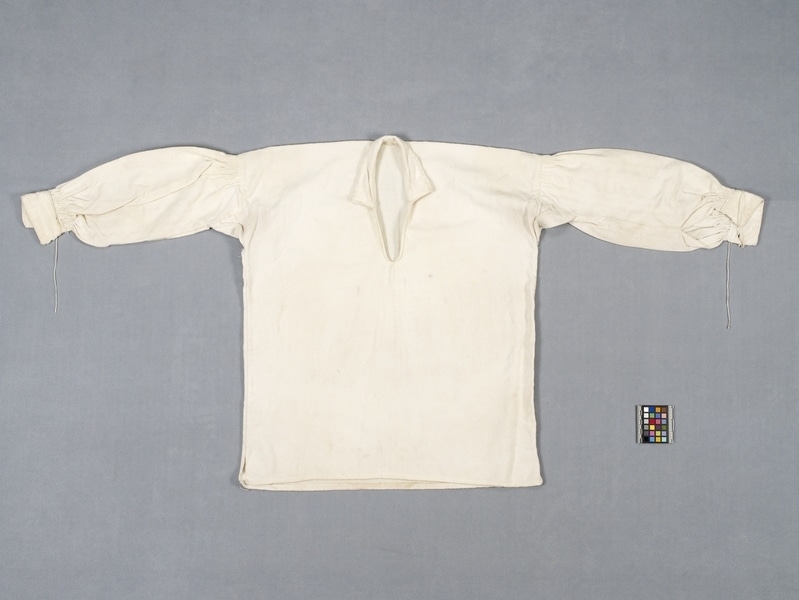Shirt Item Number: Sf960 from the MOA: University of British Columbia


Description
Shirt, pull-over with a stand-up collar, a slash neck opening, slashes at the bottom sides, underarm gussets, and gathered sleeves with cuffs. The cuffs have a cord and reinforced hole for a closure.
History Of Use
Bayeta is made by males on the treadle loom and is used for garments that are cut to size and sewn, such as trousers, shirts, skirts and vests. The style, the construction, and the loom used are non-indigenous and derive from Spanish peasant tradition. Handspun sheep's wool is the traditional material, but synthetic yarns are now used. Similar to everyday shirts except made of whiter, synthetic yarns. The Sikuri dance is a traditional dance performed by males who play panpipes and by females, June 24 (El Dia de Campesino), during the community fair, July 25-Aug. 5, and at many festivals, including Santiago, Candelaria, and Santa Cruz.
Specific Techniques
Plain weave fabric; shirt assembled from loom widths and cut rectangles by machine stitching; hand-stitched gathers at shoulder and cuffs.
Cultural Context
Male Sikuri dancer.
Narrative
Bought from Candelaria Cruz Machaca, widow of the maker and user, Augustin Quispe Mamani. Augustin had been the main source source of information on Taquile collections in previous years. The vest (Sf959), wig (Sf948) and hat were part of Augustin's Sikuri costume.
Item History
- Made by Agustin Quispe Mamani (Maker) in Taquile, Puno, Peru during 1983
- Collected by Mary Frame during 1984
- Owned by Mary Frame before May 8, 1986
- Received from Mary Frame (Seller) and Museum of Anthropology Shop Volunteers (Funding source) on May 8, 1986
What
- Name
- Shirt
- Identification Number
- Sf960
- Type of Item
- shirt
- Material
- synthetic fibre
- Manufacturing Technique
- woven, cut and sewn
- Overall
- height 80.0 cm, width 163.0 cm, depth 3.0 cm
Who
- Culture
- Quechua
- Creator
- Agustin Quispe Mamani (Maker)
- Field Collector
- Mary Frame
- Previous Owner
- Mary Frame
- Received from
- Mary Frame (Seller) and Museum of Anthropology Shop Volunteers (Funding source)
Where
- Holding Institution
- MOA: University of British Columbia
- Made in
- Taquile, Puno, Peru
When
- Creation Date
- during 1983
- Collection Date
- during 1984
- Ownership Date
- before May 8, 1986
- Acquisition Date
- on May 8, 1986
Other
- Item Classes
- textiles
- Condition
- fair
- Accession Number
- 1131/0005